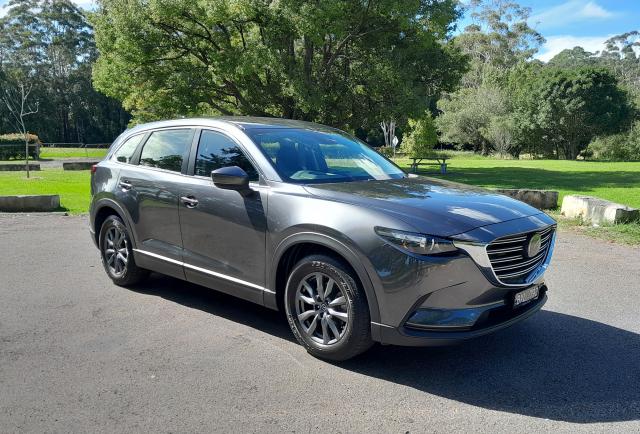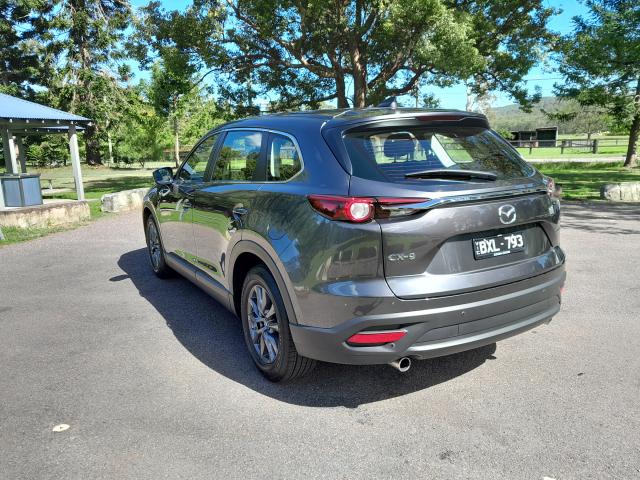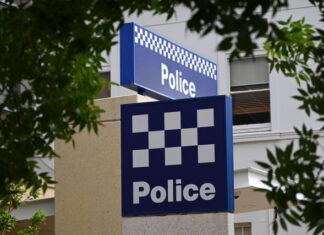A luxury seven-seat family SUV, the CX-9 has been Mazda’s flagship model since it arrived here in 2007.
With seven seats standard across its range, vehicles such as the CX-9 have effectively replaced people movers especially when they come, as the CX-9 does, with the choice of front- or all-wheel drive.
The former contributes to better performance, lower fuel consumption and reduced emissions — the latter providing extra traction for towing or mild off-road capability.
The current, second generation CX-9 has been around since 2016 and is due to be replaced in August by the all-new and significantly more expensive, CX-90.
Mazda Australia has indicated that the CX-9 will remain on sale until at least the end of this year. As such, we thought a final review worthwhile.
CX-9 is offered in Sport, Touring, GT, GT SP, Azami and Azami LE variants. All but the Azami LE are available with the choice of front- or all-wheel drive – LE is AWD only.
Our test vehicle was the entry-level Sport FWD.
INTERIOR
Mazda CX-9 is just over five metres in length and even third row legroom is almost okay for adults with access via a witch on the side of the seat cushion that tilts the seat forward.
The front seats are soft and wide, while the second row of a double bench layout has generous head and leg room.
The window line is quite high and could restrict the vision of young children.
Cargo capacity is better than many in the seven-seat class, with a reasonable 230 litres available with all seven seats in use or 810 litres with the third-row seats folded. The loading height of the floor is a comfortable 805mm.
ENGINES / TRANSMISSIONS
In contrast to the wide range of grades, there’s just the one powertrain. The Skyactiv-G2.5T turbocharged four-cylinder engine produces 170kW of peak power at 5000 rpm and 420Nm of maximum torque from a low 2000 revs.
The engine is mated to Mazda’s SkyActiv-Drive six-speed automatic transmission.
The powertrain features Mazda’s stop-and-go function, designed to maximise fuel efficiency. It works by cutting the motor when the vehicle comes to rest, restarting it once brake pedal pressure is relaxed.
SAFETY
Mazda has never been a company to cut corners on safety equipment and all CX-9 variants come with a wide range of driver support systems, including Mazda’s i-Activsense that uses radars and cameras to recognise potential hazards. There is pre-crash safety technology to prevent or reduce the severity of impacts.
There’s also smart city forward and rear brake support, autonomous emergency braking including night time pedestrian detection, blind spot monitoring, rear cross traffic alert, driver inattention alert and radar cruise control with stop/go function.
Lane departure warning is also fitted, with lane-keep assist, traffic sign recognition, high beam headlight control, Isofix child seat anchors in the outer second-row seats, and head-up display.
The only safety features missing from the CX-9 Sport are front parking sensors (Touring and above) and a 360-degree camera (Azami and Azami LE).
It almost goes without saying these days, but the big Mazda cruiser has a five-star ANCAP rating.
INFOTAINMENT
The 7.0-inch screen in the Sport looks tiny inside the CX-9’s large front console. Touring steps up to a 9.0-inch screen while all from GT upwards expand the screen to 10.25 inches.
The Mazda MZD Connect system provides access to the internet, social media, email, Pandora, Stitcher and Aha as well as hands-free voice and text messaging through Bluetooth.
Although it is a touchscreen, we quickly switched over to using the traditional Mazda Command Control knob and buttons on the centre console which are much easier to reach and use.
Satellite navigation is standard across the range as is wired Apple CarPlay and Android Auto. A wireless smartphone charging pad is located at the bottom of the front console in GT and higher variants.
DRIVING
The large dimensions of the CX-9 make for easy access. The front seats are relatively narrow but supportive and comfortable. In the entry-level Sport that we tested they lack power adjustment.
Sport does have a reversing camera, but not front parking sensors or 360-degree camera which are available in higher-spec variants.
This Mazda has good low-down torque that makes it pleasant to drive on a day-to-day basis, though it’s obviously no sports machine. An 11.8 metre turning circle can make parking a hassle in tight spaces, particularly in underground carparks.
Out of town it’s like a luxury cruising sedan with sound deadening material added as part of upgrades, meaning the cabin is lovely and quiet.
Steering is relatively light, but responsive and predicable. The ride is smooth with low levels of noise, vibration and harshness.
Sport Mode can be activated through a switch on the centre console. This increases throttle response, while moving auto transmission shift points for improved acceleration, for example when looking to overtake, or filtering on to a motorway.
Fuel consumption is listed at a combined 8.4L/100km. We were initially sceptical about what is a low number for such a large vehicle, but were pleasantly surprised when we averaged an 8.6L/100 km during our week-long test, albeit predominantly in motorway and rural conditions.
SUMMING UP
The CX-9’s spacious and comfortable cabin, refined ride and handling and very competitive pricing combine to make for a very attractive package. It’s an excellent long-distance cruiser and almost falls into the luxury saloon class.
But … it’s nearly seven years old and that shows mainly in the tech features that lag behind most competitors as well as its upcoming CX-90 successor which also brings new petrol and diesel engines.
We’ll be testing the CX-90 when it arrives around August and let you know whether the significant price increases (at least 25 percent) are justified.
All Mazdas come with a five-year unlimited kilometre warranty. Service intervals are 12 months or 10,000km.









